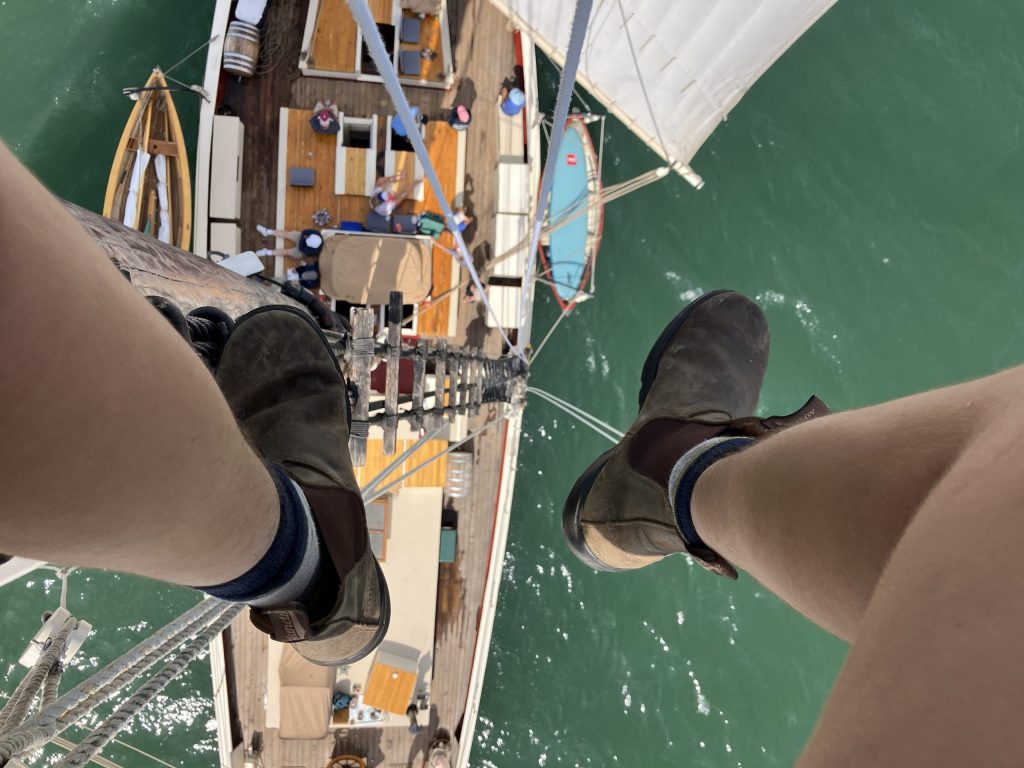
When I began thinking about what I wanted to do for my final summer as a student, there was a lot to consider. Both Bryn Mawr and the greater Philly area have a lot to offer in the way of internships, research assistant-ships, fellowships, and more. In the end, though, I decided to return to the summer job I’ve been doing since I was eighteen: working on a traditionally rigged schooner off the coast of Maine.

Going aloft
As I’ve mentioned in my previous post about sailing, working on a schooner is the most fantastic assemblage of bizarre experiences to ever count as a job. You could say it’s like working on a cruise ship, except there’s only 25 passengers and almost everything is run on 19th century technology. It’s a bit like being a camp counselor, but the camp is a bed and breakfast, and the bed and breakfast occasionally tilts at a 15 degree angle. Sometimes you’re given tasks like “clean the toilets” and other times you’re given tasks like “sit on this swing while we hoist you sixty feet in the air so you can rub down the masts with Vaseline”.
Yes, really. Vaseline.

“Look mom I’m driving a boat!”
All of the schooners in the Maine windjammer* fleet run pretty similar operations, resulting in a close-knit community with all the traditions and rivalries one would expect accompany that. This year I was deckhand on a new boat, just across the dock from where I used to work. I had sailed with one of the captains in my very first season, when I was a galleyhand and she was first mate. She taught me a lot about sailing in my first few months, and I was excited to work with her again.
*Windjammer: a term for a commercial sailing ship
Except for all the… charming idiosyncrasies you might expect from a 100 year old schooner, I was genuinely surprised at how quickly I fell back into the rhythm of windjamming after two years off. That said, the mechanics of sailing are just the tip of the iceberg where being a deckhand is concerned, and this season there was plenty to learn.

Beginning an eye splice
I took a lot of responsibility for rig maintenance, which came naturally to me as someone who enjoys fiber arts. I wove mats, secured rope ends with needle whippings, spliced, seized, and braided. I found the best time to work on more complicated projects was in the dead of night, when no one could call me away to help maneuver the boat or help prepare a meal. Whoever came to relieve me from night watch often found me tucking away my rig knife amidst scraps of line, with a half-completed project in front of me.

Weaving a sword mat
I also found myself working on a lot of systems projects. Some (installing a new pump for the shower) were significantly better than others (unclogging the black water system). There’s a reason that the cabinet in the crew cabin that grants access to the plumbing system is called the Room of Despair. I certainly spent my share of hours with my head buried in a tangle of valves and hoses, wishing I was up on deck in the fresh air. At the end of the day, though, it was satisfying to succeed in a project and know I had repaired some vital part of the boat’s functioning.

I had this plaque custom engraved and installed it as a prank.
My technical skills would occasionally give passengers pause. Once a passenger noticed me installing a saltwater pump in the fore-peak and barked, “Hey! Do you even know what you’re doing?”
I glanced down. This was the third pump I had installed that week.
“…Yes,” I said.
He humphed, then squinted, “What are you doing?”
I could only laugh. Comments like that were rare, but they weren’t unheard of. Many of our passengers are boomers, and some of them have particular ideas about gender roles. Luckily, the tone of most of the comments tend toward “shocked but complimentary”, and I’ve gotten better at taking them in stride.
The traditional sailing world has also been changing around me. I used to feel some whiplash going from a historically women’s college to a mostly male dominated industry, but every year I notice more and more women around me. When I began sailing in 2017, it was pretty notable that we had two female mates on the same dock. Now, no one seems to blink at female dominated or all-female crews.

I’ve heard of captains who wouldn’t hire women because they “weren’t strong enough” to do the work, but to a certain extent raising sails is less about how strong you are and more about how well you can use your body weight. Photo credit: Kari Heistad
Anyway, sexist comments are a relatively small thorn in my side when it comes to spending time with passengers. It’s hard to pick a favorite part of working on schooners, but a highlight is always getting to teach people about the boat. Traditional sailing is a rich and fascinating subject, and I have an incredible amount of practical knowledge that I love to share. Often, I would be working on a small rigging project and a group of passengers would gather around me just to see what I was up to. I would keep a supply of rope scraps handy to so people could try out making splices and needle whippings for themselves, and a few people took their work home as souvenirs. If a passenger was especially enthusiastic about helping on deck I would invite them to climb out on the headrig to furl sails, or assign them a permanent position helping us tack* the boat.
*Tacking is the term for turning the boat by passing the bow through the wind. It usually requires handling a lot of lines.

Sail furling lesson. Photo credit: Kari Heistad
I especially liked it when I could get kids involved. As much as I like sailing, I always felt that going on these trips as a teenage passenger would be a little lonely, as our demographics skew middle aged and older. So, I would make an extra effort to pull kids into the fold. A few of them really got into it. One of them, a very quiet teenage girl accompanying her parents on a knitting trip, stayed up on deck for a full day of foul weather and wild sailing while everyone else took refuge down below. Later that night I taught her all the knots I knew. I went to bed with her still tucked away in the galley, practicing with a piece of twine.
There were three or four other teens this summer who I wouldn’t be surprised to see return in a few years as apprentices or crew. Speaking of, I ran into an apprentice I worked with a few years ago who had decided he wanted to stay on as crew. I apparently inspired him to take a gap year to sail and travel, and he asked me for advice on emailing his school to defer.

The crew cabin. It consists of two bunks and about four square feet of standing headroom.
As crew, we spend 90% of our time out on the water, which leaves little time for anything outside of work. The 24 hours we have off between trips is just enough time for laundry, a shower, and a quiet cup of coffee. While we’re out on trips we have pretty minimal privacy, no real breaks, and long days of hard work. It can be hard to cope with, especially when you have to live with the people you work with. So, I like to lean into my goofy side to deal with the intensity of the job.
In particular, pranking is a time honored tradition in the fleet of schooners that sail in Penobscot Bay, and this year I finally had a crew that was willing to go along with me. This is how I found myself clinging to the ship’s railing one night in June, my legs unsteady as I adjusted my stance on a paddleboard. It was just past midnight, but by the light of the moon I could clearly see my target– another schooner anchored across the harbor.
I flashed a thumbs-up. My roommate/friend/co-deckhand/partner-in-crime passed me a miniature rubber chicken, which I stuffed into my pocket, and a paddle, which I hefted in a sort of salute before pushing off in the direction of the other boat. After a few heart stopping wobbles I got the hang of paddling and glided silently over to the other ship. I waited a moment to ensure I hadn’t attracted anyone’s attention, swiftly tied the rubber chicken under their bowsprit like a figurehead, and made a swift exit without ever alerting their night watch to my presence.
To my delight, the chicken was still there when we passed them again a week an a half later.

Coiling lines. Photo credit: Kari Heistad
Overall, I’m really glad I’ve stuck with sailing on schooners for all these years. I feel like I’m at a point where I’m really good at my job, and yet there’s still so many things left to learn. I also love how dramatically different life on a boat is from my life at school. I’m pretty studious and I spend a lot of my free time doing quiet, sit-still hobbies, so it’s refreshing to wrap up finals and immediately launch myself into another adventure. And, after three months of sailing, I’m happy to settle back into my spacious dorm room, crack open my books, and start my senior year.

Three deckhands vs a 500 pound anchor. Photo credit: Kari Heistad

August Sunrise

Coolest person I know!
Miss you Mayisha!